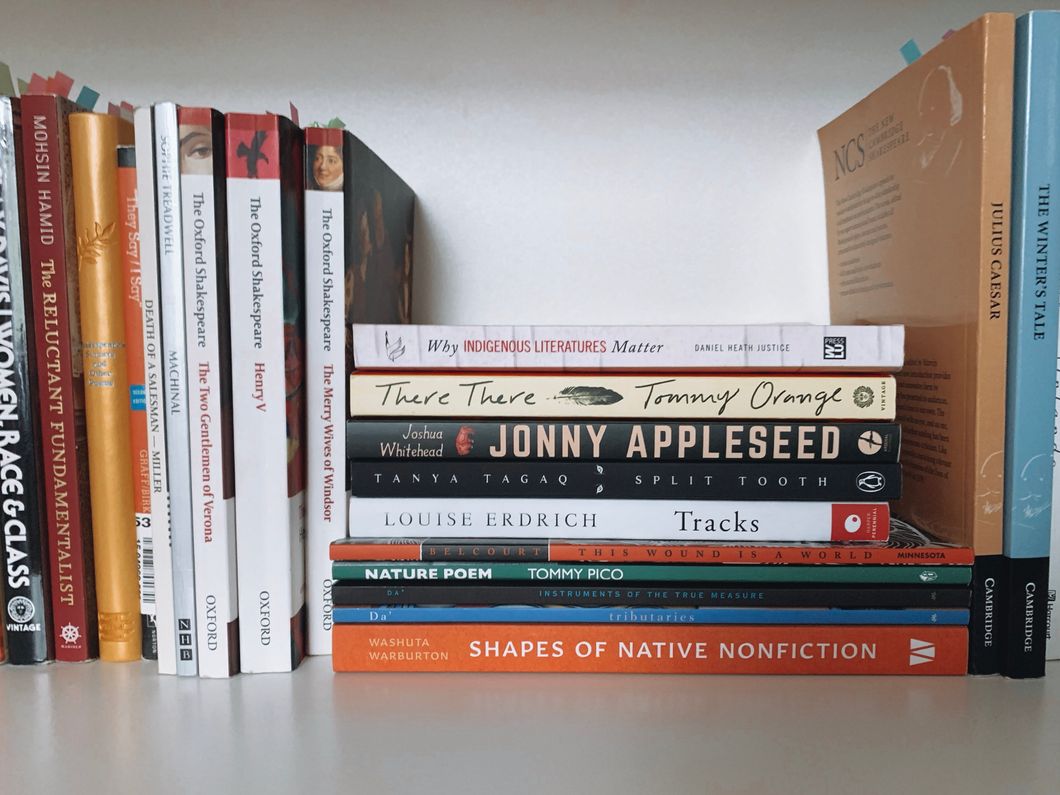For many of us, our choice of literature is inspired by class requirements, recommendations from friends, or books that are receiving a lot of media attention. These categories often leave out Indigenous literatures and authors, so I want to share some of the authors I have recently come across that you should absolutely add to your summer reading list.
1. Louise Erdrich
Louis Erdrich is the owner of Birchbark Books, an independent bookstore in Minneapolis, Minnesota, she is an enrolled member of the Turtle Mountain Chippewa, and she is the author of novels, poetry, children's books, and more. Erdrich's novels explore narrative through themes of community, place, and history, and her books tend to weave together fictional narrative with factual elements of Indigenous histories. She is known for her beloved characters that often appear in across multiple novels, and her books tend to be character-driven, following multiple perspectives at once. "Tracks", published in 2004, follows a set of characters "Over the course of ten crucial years, as tribal land and trust between people erode ceaselessly, men and women are pushed to the brink of their endurance -- yet their pride and humor prohibit surrender". "Tracks" is an engaging and deeply emotional novel, as is her award winning book, "The Round House". "The Round House", published in 2013, masterfully details the story of a young boy who "seeks justice and understanding in the wake of a terrible crime that upends and forever transforms his family". Both novels are griping and vibrant, painting remarkable narratives that you are sure to love.
Next up on my reading list are Erdrich's "The Plague of Doves" and "Four Souls".
2. Tanya Tagaq
Tanya Tagaq is most widely known for her Inuit throat singing and is originally from Cambridge Bay, Nunavut, Canada. Her debut novel, "Split Tooth", published in 2018, challenges the reader's perceptions of reality as it weaves together fiction and memoir throughout an ethereal and haunting story. Tagaq redefines the reading experience in this extraordinary novel, and I can confidently say that it is unlike anything I have ever read before. "Split Tooth" is powerfully raw, and it pushes the boundaries of believability in narrative. Following the coming of age story of a girl living in the Inuit tundra of Nunavut, "Split Tooth" uses narrative to create a fantastical reality that is guaranteed to revolutionize the way you read literature.
3. Tommy Orange
Tommy Orange's debut novel, "There There", was extremely well received when it was published just last year. As an enrolled member of the Cheyenne and Arapaho Tribes of Oklahoma, Tommy Orange's novel explores different Indigenous perspectives and characters living in Oakland, California, where he himself was born and raised. Among an abundance of awards, "There There" was named one of The New York Times 10 Best Books of the Year for 2018. The book is intricate and compelling, weaving together the lives of his characters in such a way that "this chorus of voices tells of the plight of the urban Native American—grappling with a complex and painful history, with an inheritance of beauty and spirituality, with communion and sacrifice and heroism. Hailed as an instant classic, "There There" is at once poignant and unflinching, utterly contemporary and truly unforgettable" (Penguin Random House).
4. Laura Da'
Laura Da' poetry is simultaneously readable and multilayered as many of her poems grapple with the relationship between history, memory, and narrative. Da' is Eastern Shawnee, and much of the poetry in her first book, "Tributaries", combines the narrativization of Shawnee history with her own personal experience and identity. The book won the 2016 American Book Award, and includes a lyrical style that I found to be rich, vivid, and complex. "Instruments of the True Measure" is equally evocative in the way that it parallels Shawnee history with the present, this time focusing specifically on charting "the coordinates and intersections of land, history, and culture" in which "the body and history become lands that are measured and plotted with precise instruments" (University of Arizona Press).
5. Tommy Pico
The worlds of social media and poetry collide in Tommy Pico's refreshingly honest "Nature Poem". As a member of the Kumeyaay Nation, Pico uses his poetry to explore his relationship with his heritage and the world around him through the perspective of Teebs, a queer Indigenous poet. Pico's poetry reads almost like a blog post, diary entry, or social media blast. "Nature Poem" is engaging yet quick, intended to be read in one sitting. The book functions as an experience of resistance; as he works fervently to stay beyond the reach of settler colonial stereotypes, Teebs shares his life with the reader through his relationship with history, sexuality, and the task of writing a nature poem.
Next up on my reading list is Pico's "IRL" and "Junk".
Final Thoughts...
Erdrich, Tagaq, Orange, Da', and Pico all explore different Indigenous voices, stories, and perspectives through a fabulous variation of writing styles. Their stories blend history with the present, smashing harmful stereotypes with complex, engaging narratives of urban, contemporary stories and characters. I look forward to reading more by these authors myself, and I hope that you'll find an author or two to add to your own personal collection!






 The minimum wage is not a living wage.
StableDiffusion
The minimum wage is not a living wage.
StableDiffusion
 influential nations
StableDiffusion
influential nations
StableDiffusion











